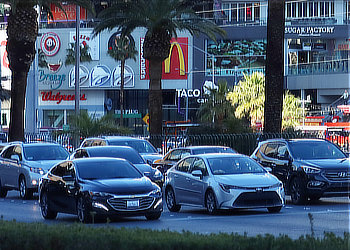Robotaxi: The Future of Mobility
Las Vegas, Nevada
Self-driving taxi in Las Vegas

Robotaxis — self-driving taxis — are opening up a whole new way of thinking about transportation, where getting from point A to point B doesn't need a driver at all.
What is a robotaxi
A robotaxi is basically a taxi that drives itself. It picks you up and takes you where you need to go — no human driver needed. Robotaxis use sensors, cameras, radar, and smart software to figure out where they are, make decisions, and safely move through traffic.
They also rely on artificial intelligence and machine learning to spot things like traffic lights, pedestrians, and other cars, helping them drive safely and smoothly.
Robotaxi benefits
Most car accidents today happen because of human mistakes, but self-driving cars could change that in a big way. Robotaxis are smart — they can plan faster routes and work together with other vehicles to cut down traffic and get you where you’re going quicker. Plus, since they run on electricity, they’re better for the environment too. And the best part? Sharing a robotaxi could cost you way less than owning a car or taking a regular cab.
Robotaxi services in Las Vegas
The Zoox (Amazon subsidiary) robotaxi has been on Las Vegas public roads since June 16, 2023.
You can also find a robotaxi on Uber or Lyft apps.
Select the UberX or Uber Comfort Electric option on the Uber app to be matched with Motional's IONIQ 5 Robotaxi.
When using the Lyft app, look for Motional's IONIQ 5 Robotaxi.
As of April 2025, Waymo is actively testing its autonomous vehicles in Las Vegas, but Waymo robotaxis are unavailable for public rides.
In case of an accident
In Las Vegas or Nevada, we don't have any specific rules for accidents caused by a robotaxi.
In case of an accident, the same rules apply as in any other motor vehicle accident.
a) The attorney must prove that negligence caused the collision,
b) Connect that negligence to the victim and
c) File a claim for monetary compensation for all medical bills (past, present, and future) and other damages.
Who is liable?
Based on the current laws, the at-fault driver (or their driver's insurance) is financially responsible for all damages, including medical bills and other damages. But in fully autonomous robotaxi, the human driver doesn't exist.
The primary liability in robotaxi accidents lies on the vehicle owner or operator. Their business insurance will pay for all damages. The way it stands today, in most cases, the owners and operators of robotaxi fleets are vehicle manufacturers. Some ride-sharing companies also own robotaxis.
Are autonomous vehicles always at fault?
No. When we talk about the at-fault vehicle, it doesn't mean the fully autonomous robotaxi is always at fault; another driver could be negligent, too, and responsible for the accident. The pedestrian could be careless, disobey the road rules, and cause an accident. Humans can vandalize or purposely confuse the vehicle.
What can cause an accident?
So far, we haven't seen yet serious robotaxi accidents, but here is the list of reasons accidents may occur:
Technical failures: Malfunctions in sensors, software, or other autonomous systems can lead to accidents if the vehicle misinterprets its surroundings.
Sensor interference: Environmental factors like extreme weather conditions, fog, heavy rain, or even bright sunlight can interfere with sensors' accuracy, leading to accidents.
Software glitches: Errors or bugs in the self-driving software might cause the vehicle to make incorrect decisions or respond unexpectedly to situations.
Human error (other drivers/pedestrians): Accidents can still happen if other human drivers or pedestrians act unpredictably or make mistakes that the robotaxi cannot anticipate or avoid.
Road infrastructure issues: Poorly marked roads, unclear signage, or unexpected road conditions can confuse autonomous vehicles, potentially leading to accidents.
Hacking and cybersecurity breaches: Autonomous vehicles are vulnerable to hacking attempts. A cyberattack can compromise the vehicle's control, leading to accidents.
Ethical dilemmas: Autonomous vehicles might face situations where they have to make moral decisions during accidents, raising complex questions about how these decisions are programmed.
Interference from humans: Vandalism, deliberate attempts to confuse the vehicle, or force the car into risky situations can lead to accidents.
Lack of vehicle-to-vehicle communication: Without proper communication protocols, autonomous vehicles might have difficulty predicting the behavior of other vehicles, potentially causing accidents.
Maintenance issues: If a robotaxi is not adequately maintained, problems with brakes, tires, or other essential components can lead to accidents.
Inadequate training data: If the machine learning algorithms lack diverse and comprehensive training data, the vehicle might struggle in unfamiliar or rare situations, leading to accidents.
It's worth noting that while autonomous vehicles have the potential to reduce accidents caused by human error significantly, they are not entirely immune to challenges. Manufacturers and developers are continually working to improve technology, safety systems, and the ability of these vehicles to handle unpredictable scenarios.
First responders
Police and fire departments are now getting special training on handling robotaxi accidents. Waymo prepared a Emergency Response Guide and Law Enforcement Interaction Protocol for first responders.
Like any other vehicle, the police will check for a robotaxi vehicle registration, auto insurance, and a permit to operate in Nevada. Robotaxi services also provide the Rider's Support and Road Assistance in case of vehicle malfunction or collision.
NRS statutes for autonomous vehicles
NRS-482A covers Nevada laws and regulations for autonomous vehicles.
NRS-482B - The proposed regulation still needs to be approved.
Settlements
Typically, medical bills (past, present, and future) are crucial in calculating accident injury compensation. If there are no medical bills, only property damages, you can file a liability claim directly with the at-fault party vehicle insurance. In most cases, they will reimburse you for property damages.
The same applies to any robotaxi accident.
When multiple parties are involved
Nevada law allows you to file a lawsuit against some or all defendants responsible for the accident. Also, if multiple victims were involved, under Nevada law, all victims who filed a claim must be compensated for damages. The same rules apply if you get in an accident involving a robotaxi.
If you were partially at fault
Nevada uses the rule of modified comparative negligence. It means the plaintiff can collect compensation from all other at-fault parties if the plaintiff was less than 51% responsible for the accident. The same is true about robotaxi accidents.
Victims with prior injuries
A robotaxi or not, pre-existing injuries may affect your settlement. You are still entitled to accident compensation, but it may lead to a smaller payment in some cases.
Do I need an attorney?
Not always. Insurance companies in Nevada pay many liability claims without the need for legal action.
Attorneys typically get involved when:
- There are disagreements about who is at fault,
- There are disagreements about the injury compensation amount,
- The plaintiff seeks additional damages.
However, if you get injured in an accident involving a robotaxi, end up in a hospital, and miss work, you may need an attorney with expertise in autonomous vehicle technology. We invite you to call us at 702-432-1000 to discuss your case.
We represent clients in Las Vegas and Nevada.
Final thoughts
We plan to follow the laws surrounding robotaxi services in Las Vegas or Nevada very closely and update this article with new information as soon as it becomes available.
Stay tuned!
Last updated on April 26, 2025.

